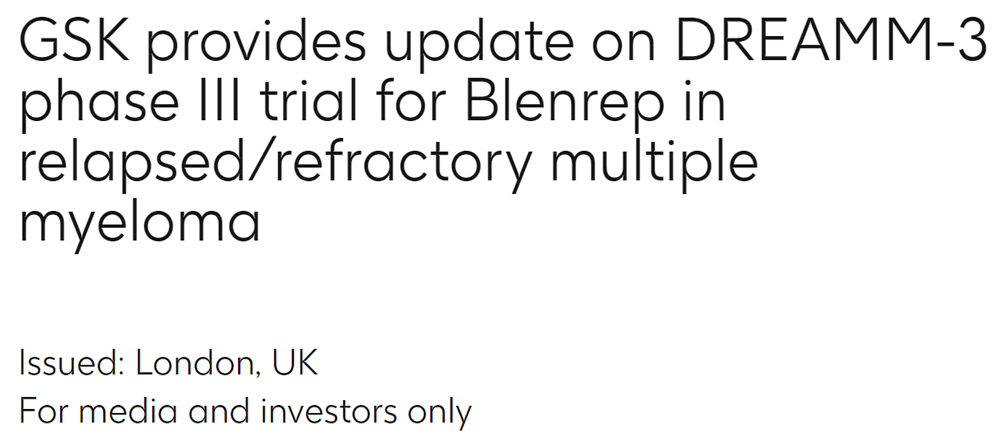On November 7, GSK announced that the Phase III open-label, randomized, head-to-head superiority DREAMM-3 trial failed to meet the primary endpoint of progression-free survival (PFS). The study was designed to compare Blenrep (belantamab mafodotin) monotherapy versus pomalidomide (pomalidomide) combined with low-dose dexamethasone (PomDex) in the treatment of relapsed or refractory multiple myeloma (RRMM).
GSK plc (LSE/NYSE: GSK) today announced that DREAMM-3, the phase III open-label, randomised head-to-head superiority trial of Blenrep (belantamab mafodotin) monotherapy versus pomalidomide in combination with low dose dexamethasone (PomDex) in patients with relapsed or refractory multiple myeloma (RRMM), did not meet its primary endpoint of progression-free survival (PFS).
Blenrep is an antibody-drug conjugate (ADC) composed of a humanized anti-BCMA monoclonal antibody and a cytotoxic drug auristatin F coupled through a non-cleavable linker. Accelerated FDA approval on August 6, 2020 as a single agent for the treatment of adult patients with RRMM who have received at least four therapies, including an anti-CD38 mAb, a proteasome inhibitor, and an immunomodulator .
Its accelerated approval is based on ORR, DOR results from the DREAMM-2 study and is contingent on clinical benefit confirmed in a randomized phase III clinical trial. GSK said it is sharing data from the DREAMM-3 trial with health regulators.
In the DREAMM-3 trial, the hazard ratio (HR) for the primary endpoint of PFS was 1.03 (95% CI: 0.72 1.47). Median progression-free survival was longer in the Blenrep group than in the PomDex group (11.2 months vs 7 months). Secondary endpoints included overall response rate (ORR), duration of response (DOR), and overall survival (OS). The ORR was 41% in the Blenrep arm and 36% in the PomDex arm. Response rates were higher in the Blenrep arm compared to PomDex, with 25% of patients achieving a very good partial response (VGPR) or better, compared with 8% in the PomDex arm.
The median follow-up time was 11.5 months and 10.8 months in the Blenrep and PomDex groups, respectively; the median DOR was not reached in the Blenrep group (95% CI: 17.9, -) and 8.5 months in the PomDex group (95% CI: 7.6 ,—); the DOR rates at 12 months were 76.8% (Blenrep) and 48.4 (PomDex), respectively. The drug’s safety and tolerability were consistent with known safety profiles, and no new safety signals were identified. The overall incidence of grade 3 keratopathy was consistent with previously reported data.
At the time of the preliminary efficacy analysis, OS data reached only 37.5% of total maturity. The median OS was 21.2 and 21.1 months in the Blenrep and Pomdex groups, respectively, with a HR of 1.14 (95% CI: 0.77, 1.68).
Additional clinical trials planned in the DREAMM series will continue. These trials are designed to demonstrate the benefit of Blenrep in combination with a novel therapy and standard of care regimens in early treatment regimens, as well as dose optimization to reduce corneal events while maintaining efficacy. Data from the Phase III DREAMM-7 and DREAMM-8 trials are expected in the first half of 2023.









